From Canarinho To Zakumi: 35 Iconic Football Mascots
It was 1966 when the trend of incorporating mascots in the FIFA World Cup began, and it has been consistently carried out ever since. World Cup Willie holds the distinction of being one of the first mascots associated with a large-scale sporting competition. Each event of the World Cup introduces a unique character each time that is efficiently able to represent a characteristic of the host country, such as flora, fauna, culture, etc.
Having a mascot also has huge benefits for FIFA and its fans. A well-designed mascot can have a significant impact on reflecting an organization’s brand value. And sports fans may find good luck with a mascot, which makes sense since mascotte is the French word for “lucky charm.”
With the Qatar World Cup 2022 fast approaching, let’s go over all of the mascots we’ve seen so far in the history of the World Cup and other football-based sporting events.
England 1966: World Cup Willie
1966 was a glorious year for England as it not only hosted the World Cup but also managed to bag the auspicious cup. As we mentioned before, it was the first tournament to introduce an official mascot, Willie the Lion.
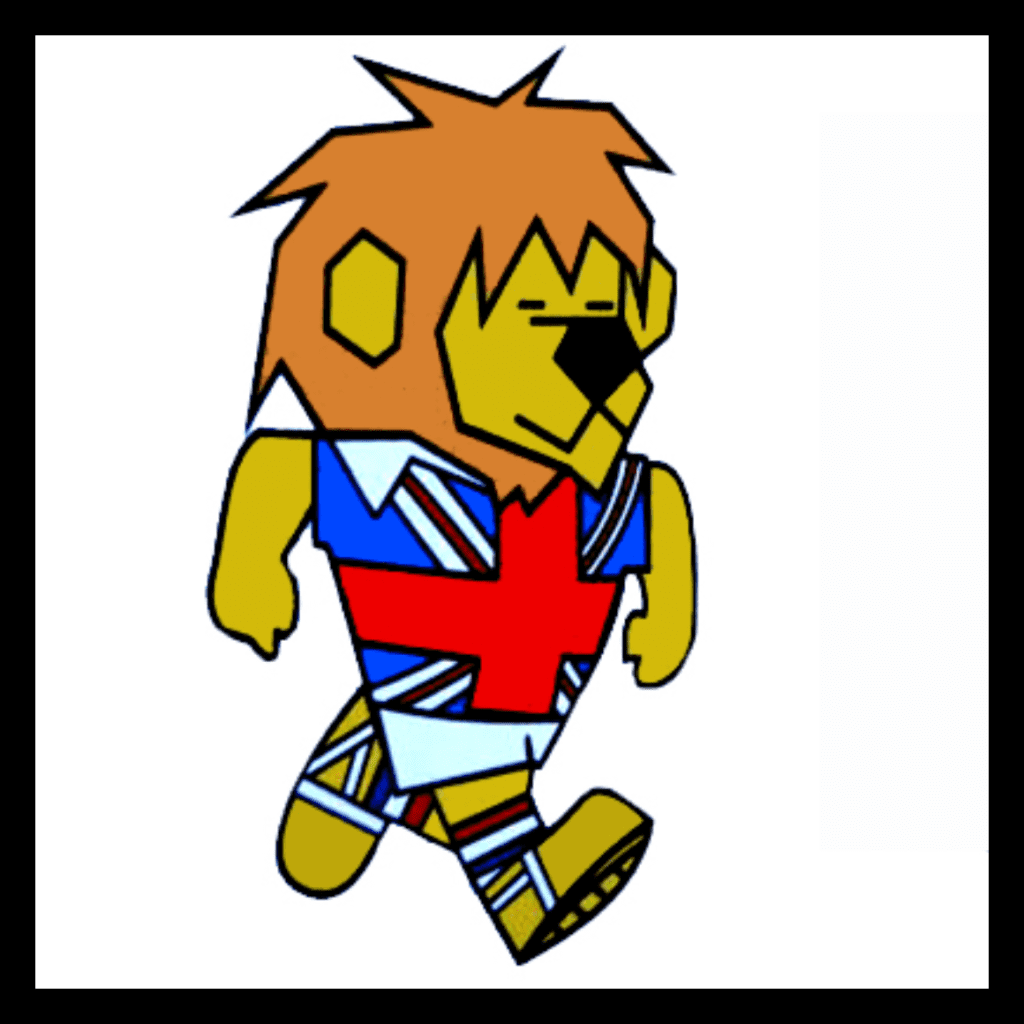
Wearing a Union Jack jersey with “WORLD CUP” imprinted on the front, Willie the Lion graced the center stage of the playground and paved the way for other mascots to come in the upcoming years. The English lion was represented as a traditional symbol for the host of that year.
Mexico 1970: Juanito
Following Willie’s unprecedented levels of fame, it was time for Juanito to shine. It’s almost hard to forget the picture of the little boy dressed in a Mexican jersey paired with a sombrero and a straw hat with the words “MEXICO 70” written on it.
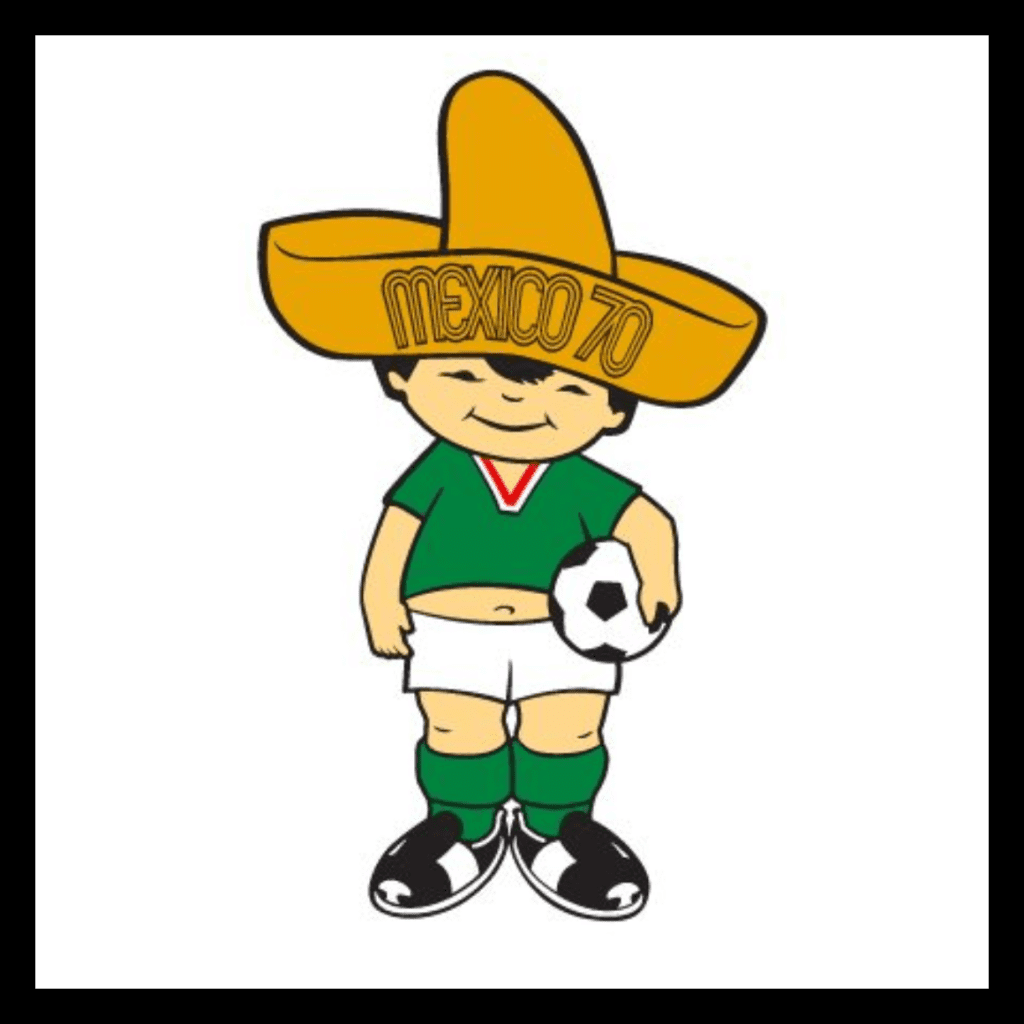
The 1970s was the first time the World Cup was going to be broadcasted in color, and thus the bright green outfit was fitting for the occasion. Rocking the high hat and short shirt combo with the boyish smile, Juanito is certainly a recognizable character.
West Germany 1974: Tip and Tap
West Germany, the 1974 host, followed the footsteps of their predecessor host in terms of the theme. The iconic duo of Tip and Tap wearing white shirts perfectly emulated the scenery with one bearing the letters WM (Weltmeisterschaft, German for World Cup), while the other sporting the number 74.
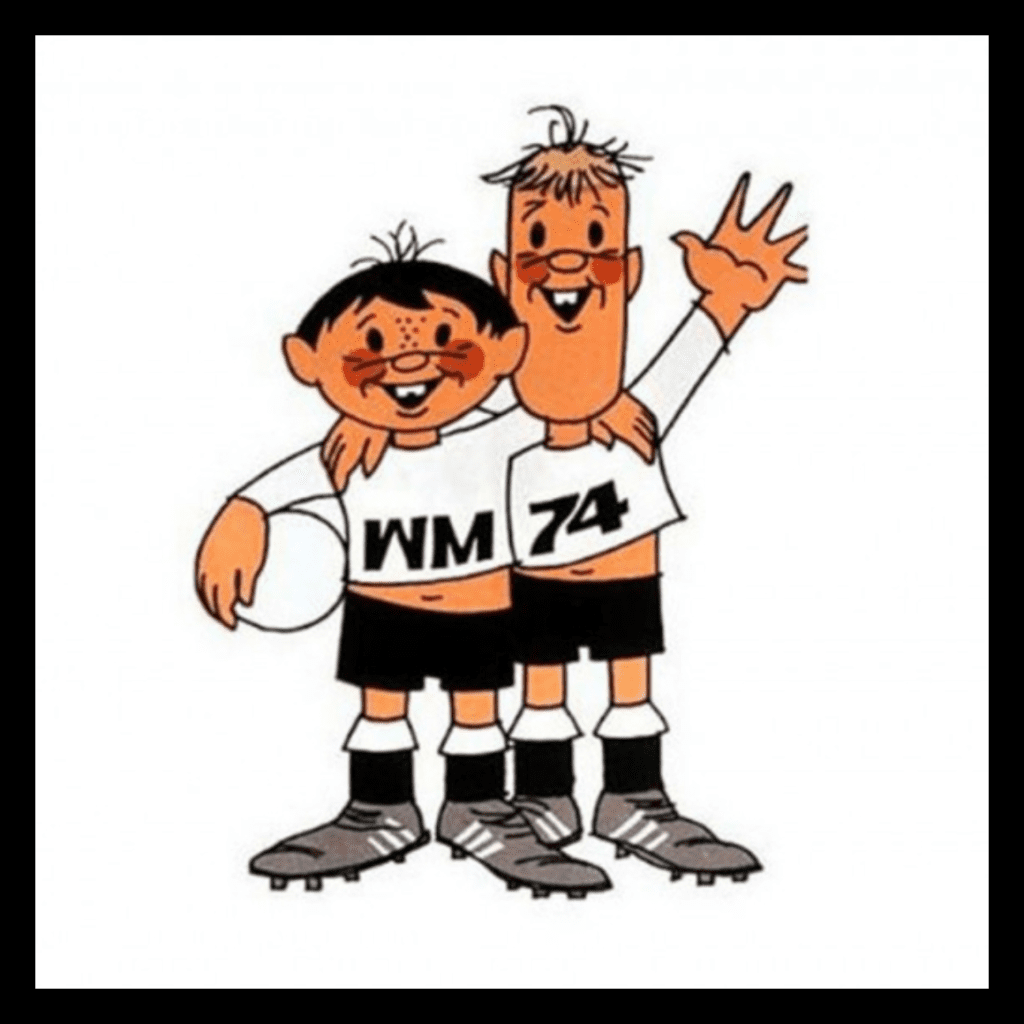
The German twins successfully gained a lot of recognition, most notably for the message the two boys portrayed. Unlike the previous years, West Germany chose two mascots. The duo represented unity and friendship, a theme that made a comeback in later football mascots.
Argentina 1978: Gauchito
A little over a decade after Willie’s entrance, it was Argentina’s turn to host…and to create a mascot to share with the world. Gauchito, the 1978 mascot, was adorned in pale blue and white. His clothing was meant to represent the country’s flag.
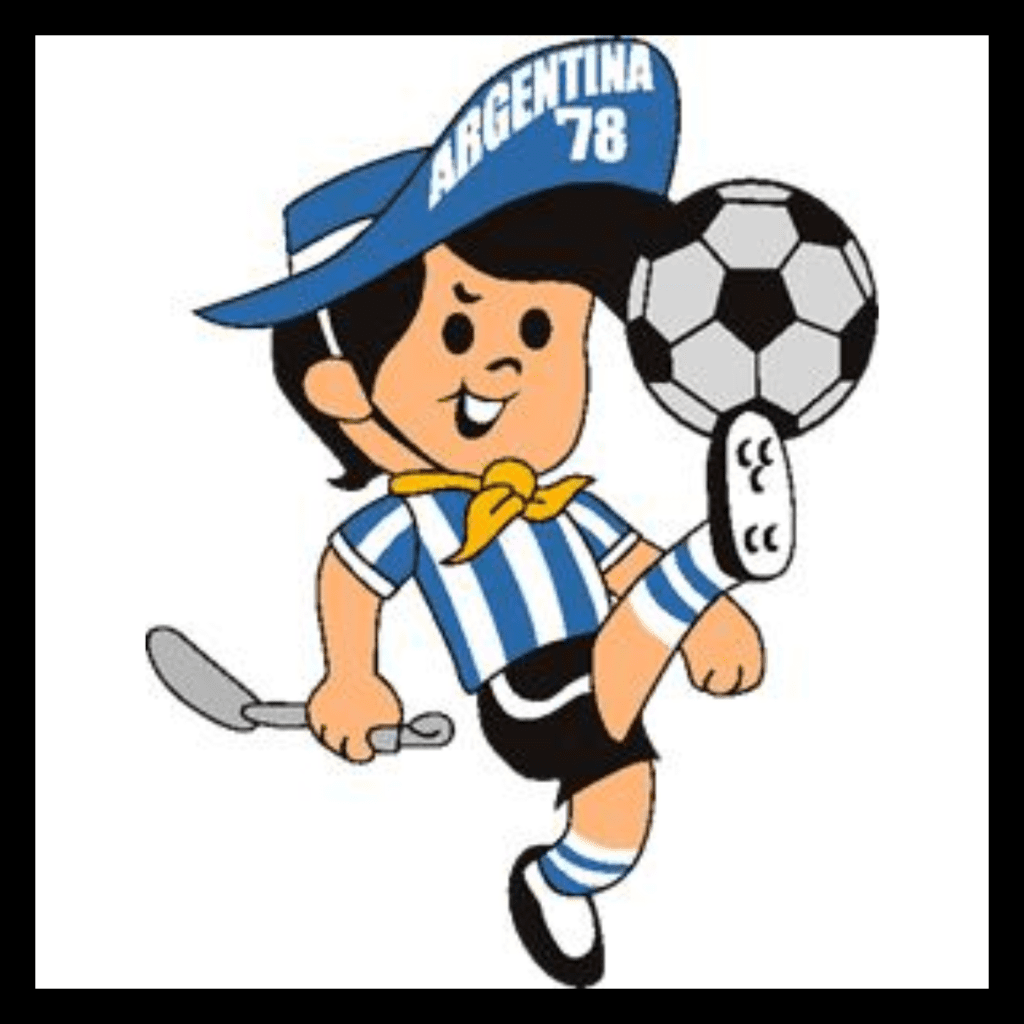
The young boy was dressed in the country’s football clothing, capped off with a hat (pun intended) bearing the country’s name and the year of the event. He also spotted a yellow neckerchief and carried a white whip representing typical gaucho symbols. And the enthusiastic smile was something all FIFA fans could relate to.
Spain 1982: Naranjito
The hosts of 1982, Spain, opted for a fruity theme for their event. More than that, they made a statement by going against the norm set by previous host nations. In 1982, a fruit was the mascot. Naranja means “orange” in Spanish, and that’s how Naranjito came to be.
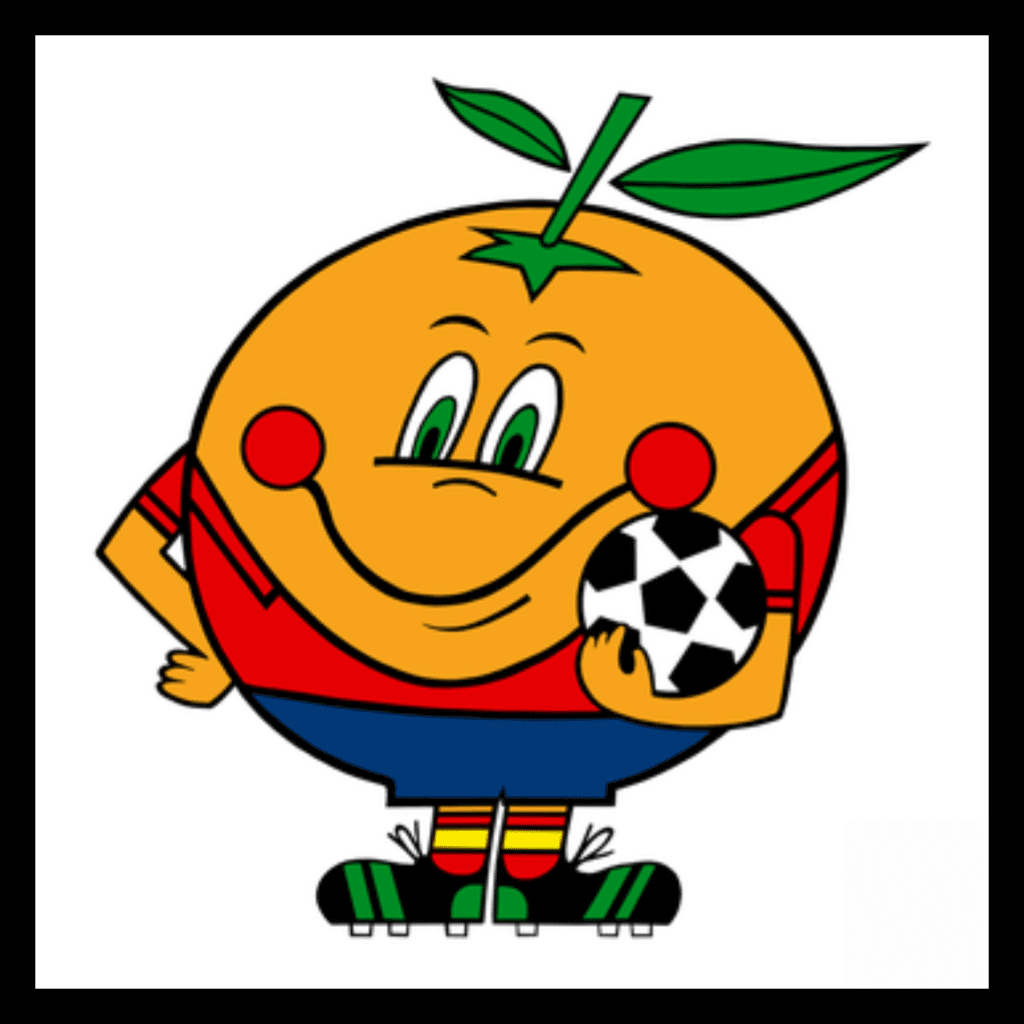
With a big bright grin and a football on its left arm, dressed in the host nation’s football attire, Naranjito was depicted as the symbol of positivity. Needless to say, this adorable clementine certainly made quite a sweet impression in our hearts.
Mexico 1986: Pique
Two-time FIFA World Cup host nation, Mexico, returned with the sombrero look. But this time, instead of a boy wearing the outfit, it was a huge chili pepper named Pique. The name stems from the Spanish word picante, meaning spicy, which represented the luscious spices and sauces the host is renowned for.
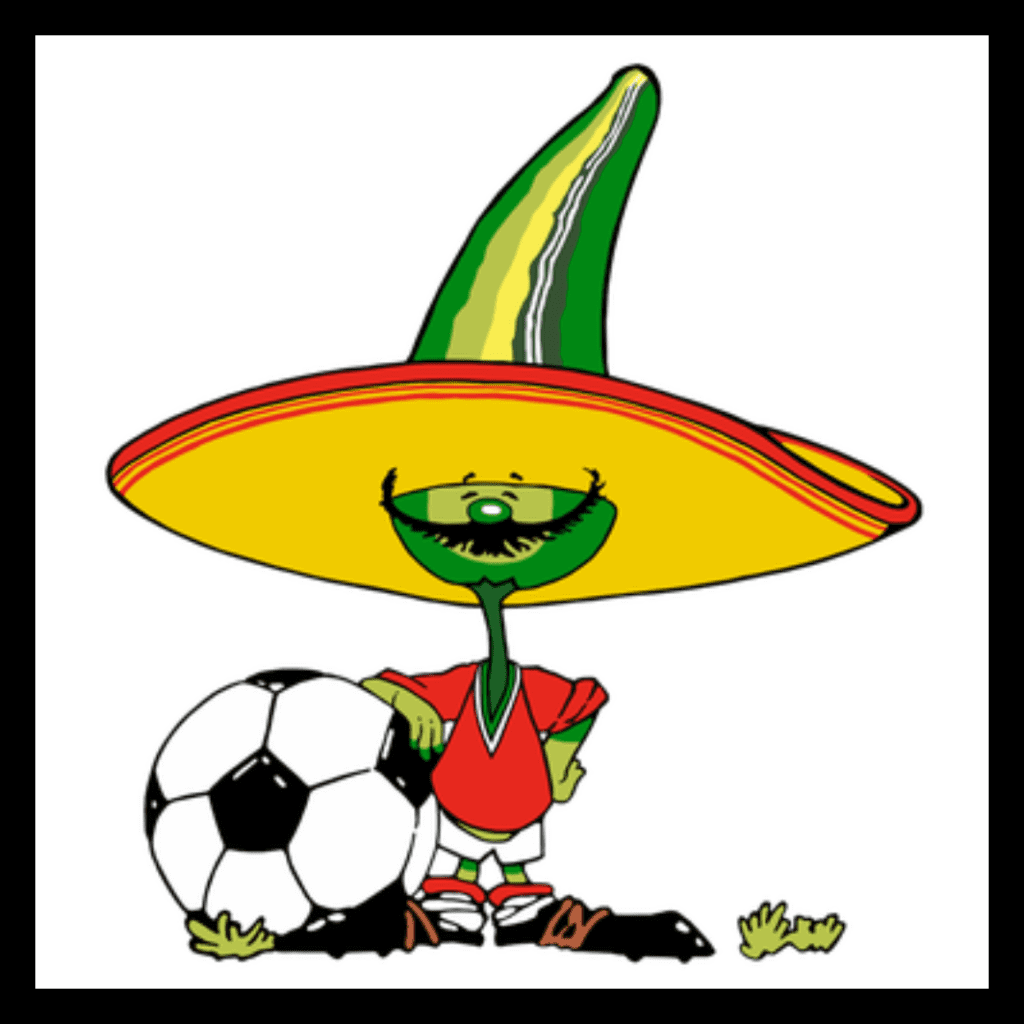
With its overly large sombrero and distinguished mustache, the jalapeno pepper clearly exuded a cheerful yet charismatic personality. It also effortlessly continued the theme of incorporating fruits and vegetables as mascots following Naranjito’s footsteps. We wonder if there were increased sales of jalapenos that year…
Italy 1990: Ciao
The informal greeting ciao is used for both “hello” and “goodbye” in Italian. The mascot named after the phrase was one of the first mascots without a prominent face. Plus, it also strayed away from the usual cuddly and fluffy nature of the previous mascots.
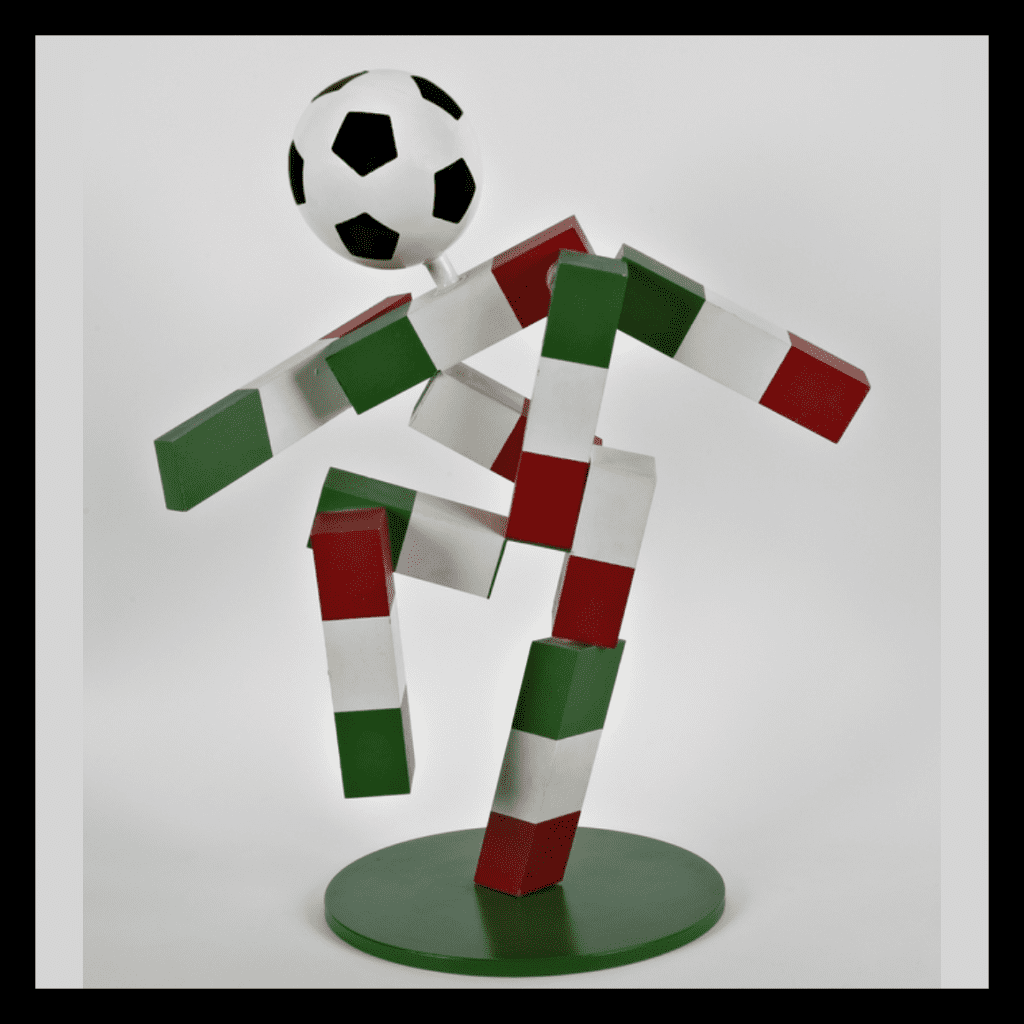
They did keep the theme of a figure playing the sport. The agile stick figure is shown donning the colors of the Italian flag with a football in the place of the head. Despite Italy not qualifying for the tournament, Ciao’s distinct look is still etched in our memories.
USA 1994: Stryker
The official mascot for the USA FIFA World Cup in 1994 was Striker. For the first time since Willie the Lion, FIFA once again had an animal mascot. Obviously, Striker’s outfit colors reflect the USA’s flag, and the 94 refers to the year of the event.

Although the mascot wasn’t particularly amazing, but the animal chosen fit rather well. Dogs are common pets in the US, and thus it made sense to have a dog as their official mascot. Additionally, the mascot was designed by Warner Bros. Animation.
France 1998: Footix
If you didn’t know, the rooster is one of Franche’s national symbols. So, in 1998, the official mascot was a beaming red and blue rooster. Footix is considered one of the most colorful mascots to date with its bright red head, blue body, and bright yellow beak.

It turns out Footix’s exuding positivity was all that was needed for France to win the tournament that year. With a brilliant team consisting of top-notch players like Zinedine Zidane, Marcel Desailly, Laurent Blanc, and a young Thierry Henry, the scene was all set for France to bag the cup.
Korea/Japan 2002: Ant, Kaz and Nik
Korea and Japan are always known to be innovative in every aspect, whether it be their culture, food, or technology. Thus, it was no surprise when the mascot from these hosts had a futuristic twist. Further breaking from tradition, they included three mascots.
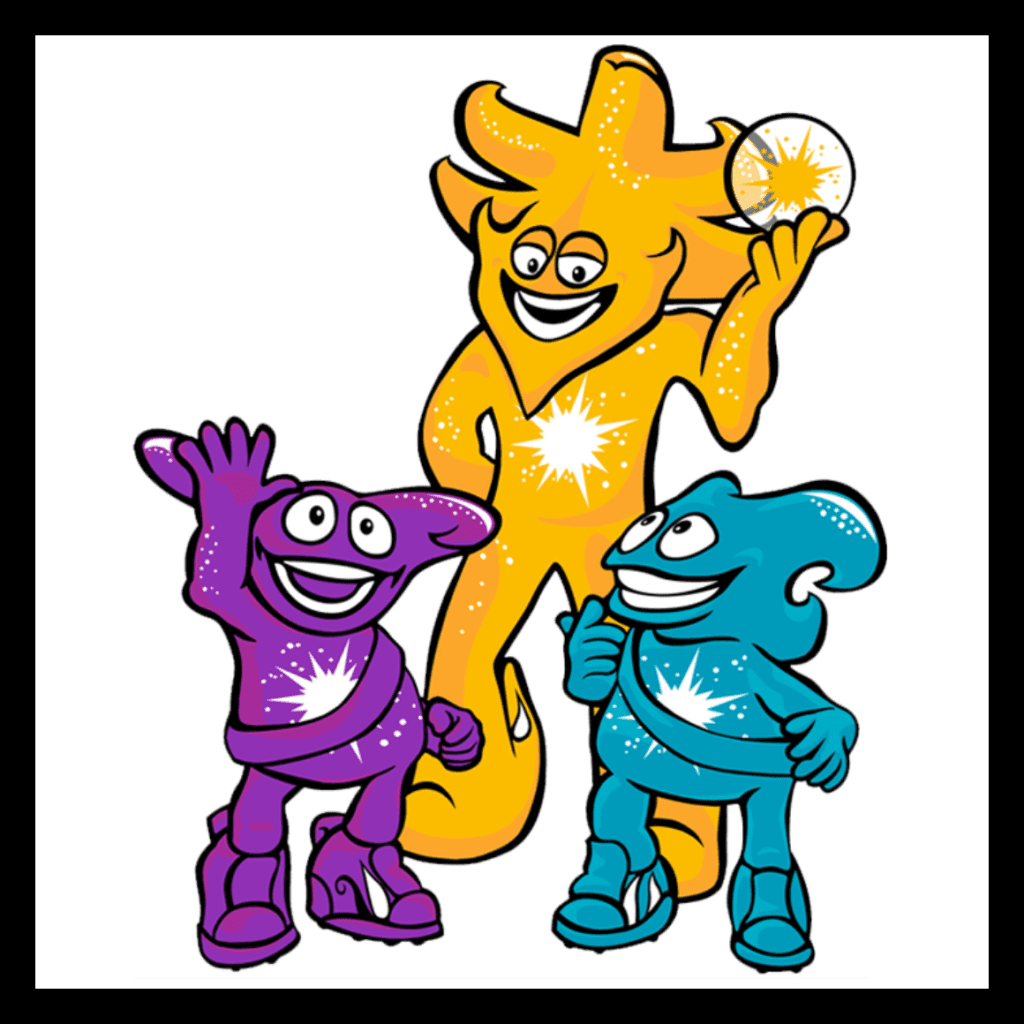
The three futuristic, computer-generated creatures were named Ato, Kaz, and Nik. The trio is also known as the “Spheriks,” belonging to the “Atmozone,” where they play “Atomball,” a fictional football-like sport. Ato is the coach in the Atomzone, and the latter two are his players.
Germany 2006: Goleo VI & Pille
Goleo VI and his sidekick Pille were introduced to the world of football in 2006, and it was hosted by none other than Germany. With Goleo VI, the iconic lion mascot also made a comeback. Goleo gets his name from the words “goal” and “leo.”

This 2006 duo still has a stronghold in people’s hearts as it was recently voted as their favorite mascots of the past five World Cups. As for his outfit, Goleo is also seen sporting a German shirt, with the year of the event, 06, printed on the back.
South Africa 2010: Zakumi
Zakumi, the 2010 FIFA World Cup mascot, was big and bold. Adorned in the national colors of South Africa, where the tournament was being held, the leopard-based character pays tribute to one of the common animals found in the country.
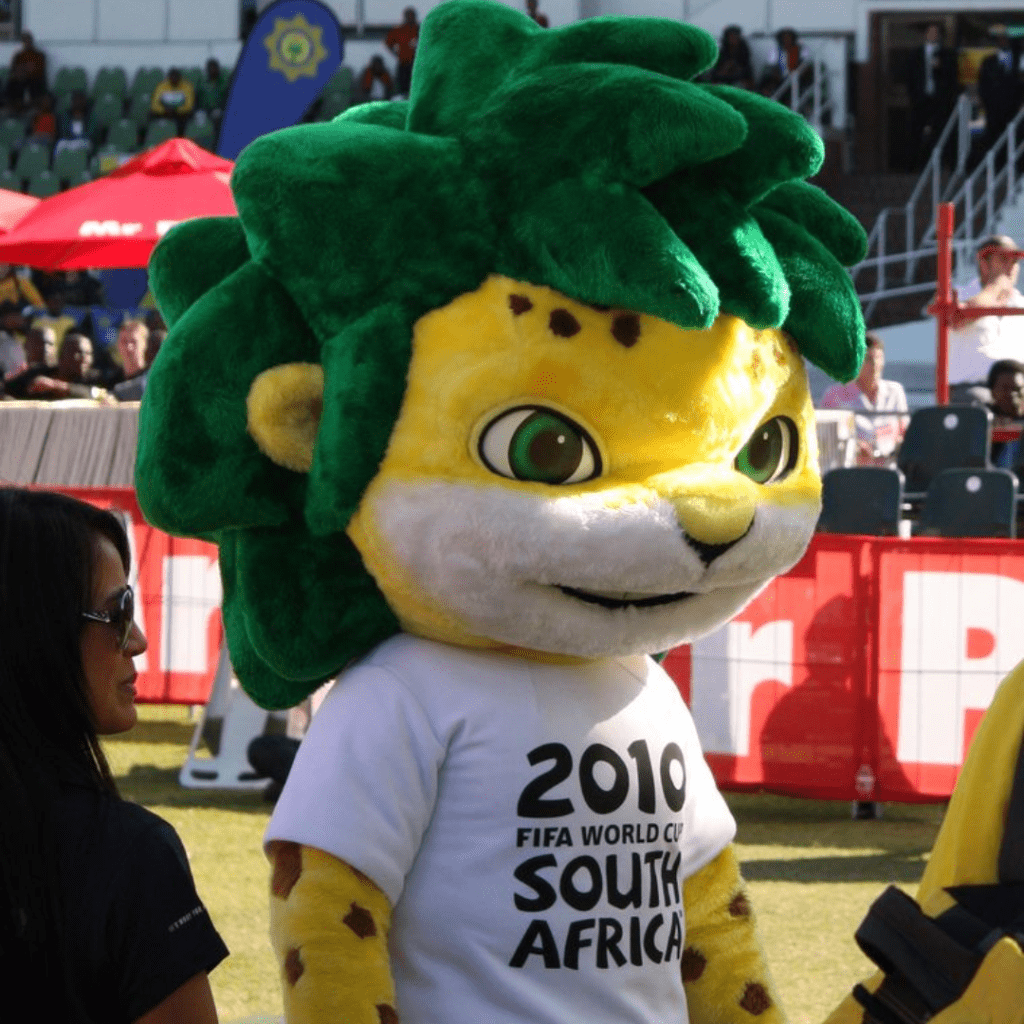
The mascot features piercing emerald eyes, green hair, spotted-yellow print, and dons green shorts and a white shirt with “SOUTH AFRICA 2010” written on it. Zakumi’s name is a composition of “ZA,” for South Africa, and “kumi,” which translates as “ten” in various regions in Africa.
Brazil 2014: Fuleco
Based on a three-banded armadillo, an endangered species also known as “tatu-bola,” Brazil’s FIFA World Cup mascot in 2014 was Fuleco. Yet again, the chosen mascot’s name held significance. The name of the mascot is a fusion of the words “futebol” and “ecologia.”

Fuleco is seen sporting blue armor and a golden body with a white shirt, with the words “BRASIL 2014” written on it, with a pair of green shorts on his bottom. The blue shell is a representation of the protection of the natural beauty of Brazil.
Russia 2018: Zabivaka
Russia’s official mascot in 2018 was a fun, charming, and confident wolf known as Zabivaka. The name of the mascot literally translates as “the one who scores.” The design of the mascot had two contenders, and after over one million votes, Zabivaka’s current design was finalized.

Zabivaka has a full backstory, too. His one true dream is to become a football star, and it is also deemed his favorite pastime. He is considered a skillful, fair player and respects his teammates dearly. He is also the life of the party!
Qatar 2022: La’eeb
The official mascot of FIFA World Cup 2022 held in Qatar is La’eeb. The adventurous, fun, and curious mascot was finally introduced during the final draw which took place in Doha. La’eeb is an Arabic word that translates to “super-skilled player.”
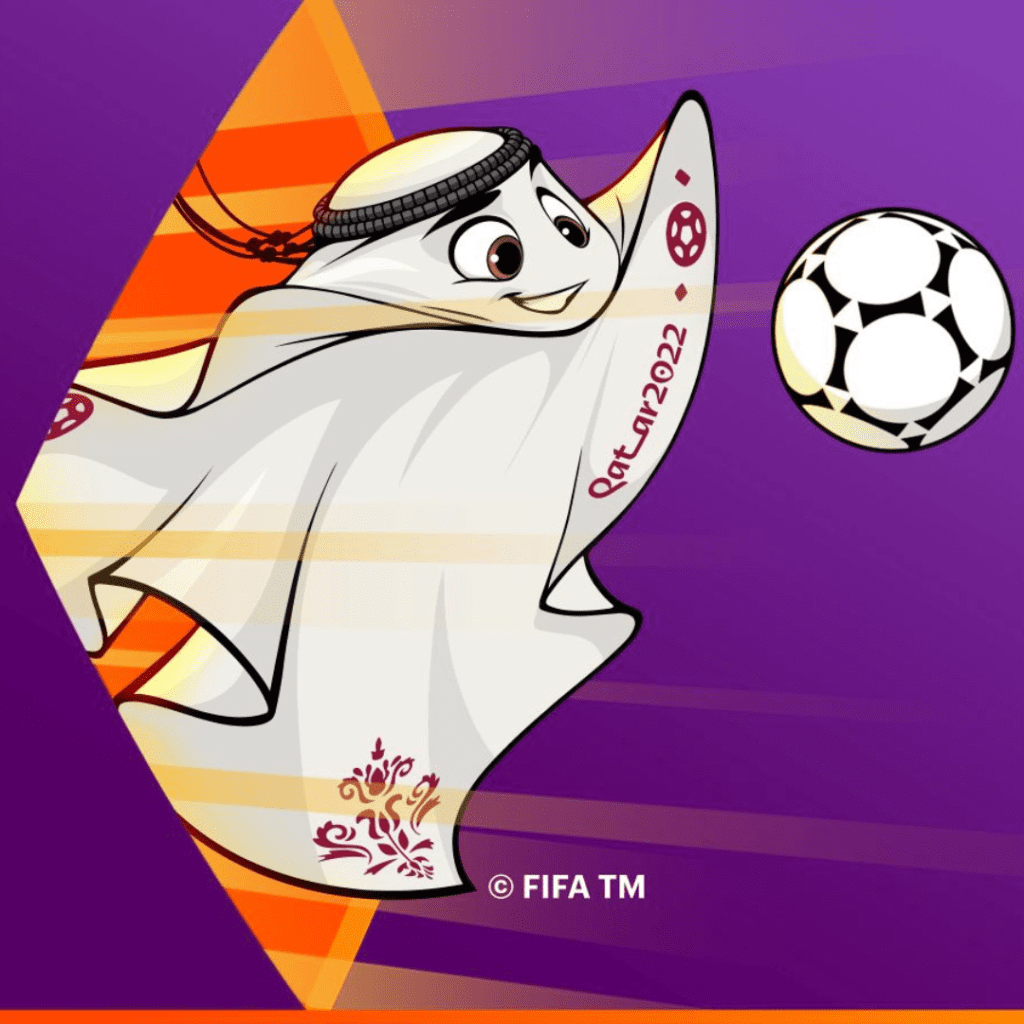
The courageous and uplifting mascot will be known for its youthful spirit in the quest to spread joy and confidence everywhere. The mascot is also known to come from a parallel world where tournament mascots live. This world is known to have a surplus of ideas and creativity forming the basis of these characters.
Brazil 2019: Zizito
The Copa America 2019 tournament, held in Brazil, chose Zizito the Capybara as their official mascot. According to tournament organizers, he was supposed to be called Capibi, but the name was changed to pay homage to former Brazil star Zizinho.

Together with Norberto Mendez of Argentina, Thomaz Soares da Silva (Zizinho) scored 17 goals in the history of the Copa America, which is a tournament record. The name Zizito was chosen officially after getting 65 percent of votes against the name Capibi.
Brazil 2021: Pibe
The Copa America 2021 tournament, which was held in Brazil, saw Pibe the dog as their official mascot. Pibe is also the 14th officially selected mascot in the history of Copa América. The mascot was officially introduced on December 1st, 2019.

The funny, cheerful, and agile dog is meant to represent the dogs that invade football fields all over South America. As for the name, the tournament organizers of the Copa América had organized an online voting session through their official Twitter account to select a name for the mascot.
Chile 2015: Zincha
The official mascot of the 2015 Copa America in Chile is a young culpeo fox known as Zincha who enjoys football. The culpeo fox was chosen as the mascot because it can be found all throughout Chile and South America.
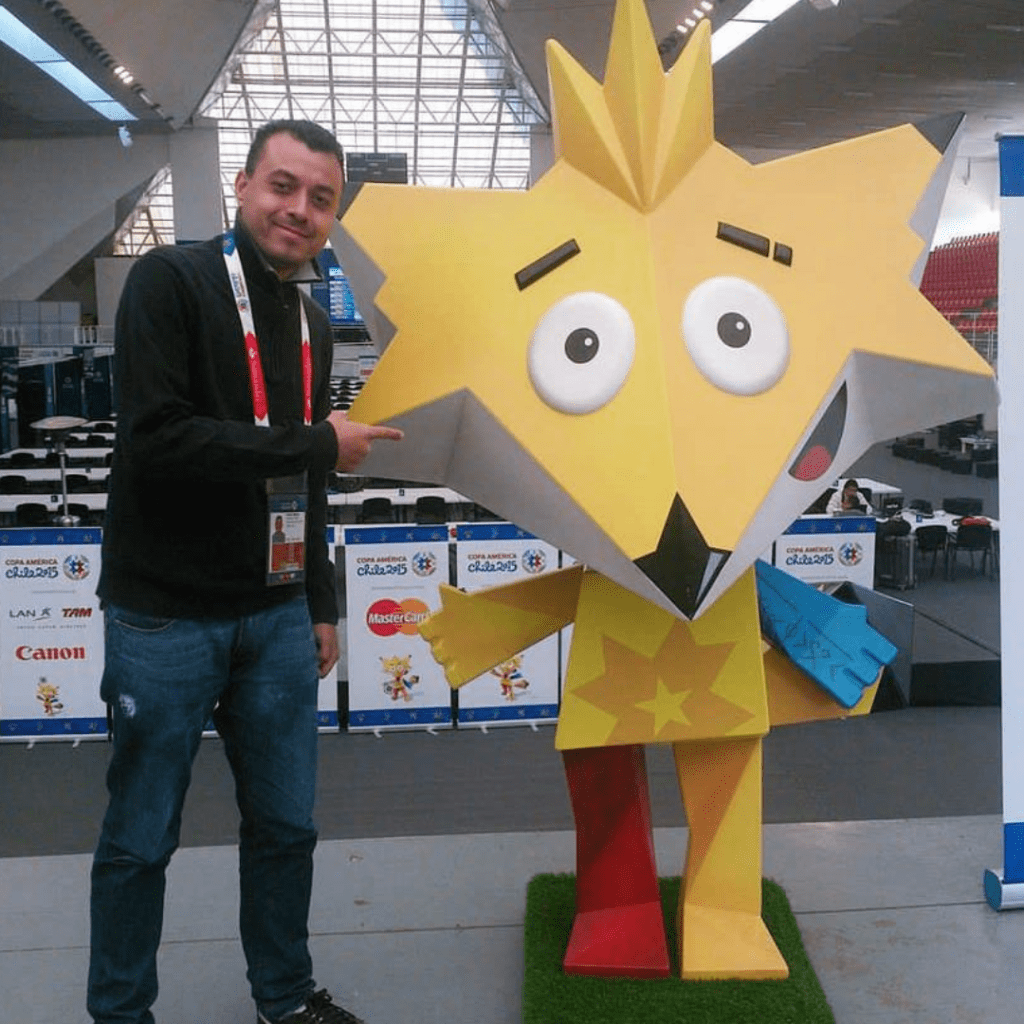
Zincha gets her name from a combination of the words “zorro” and “fan.” In a bit of creative liberty, the mascot’s limbs are multicolored, with a combination of red, blue, and orange. Furthermore, its shape reflects Chile’s indigenous culture. Zincha’s name beat Andi and Kul and made its name as the official one.
Venezuela 2007: Guaky
The official mascot of the 2007 Copa América in Venezuela was Guaky the bird. The bird is dressed in the burgundy shirt of Venezuela’s national football team. Additionally, he is also seen holding a ball with the words “Venezuela 2007” printed on his chest.

Scarlet macaws are the national bird of Venezuela, and Guaky counts himself among the flock. The mascot is sporting football cleats and the traditional burgundy jersey of the national team. With its eight stars on his wings, the national flag’s tricolor emblem is also displayed beneath his wings.
Euro 2020: Skillzy
For the summer tournament of UEFA, the authority created an interactive mascot for the Euro 2020 named Skillzy. Skillzy’s vision takes inspiration from freestyling, street, and panna culture, and is described as a larger-than-life character. The free-spirited humanoid is meant to be an interactive mascot.
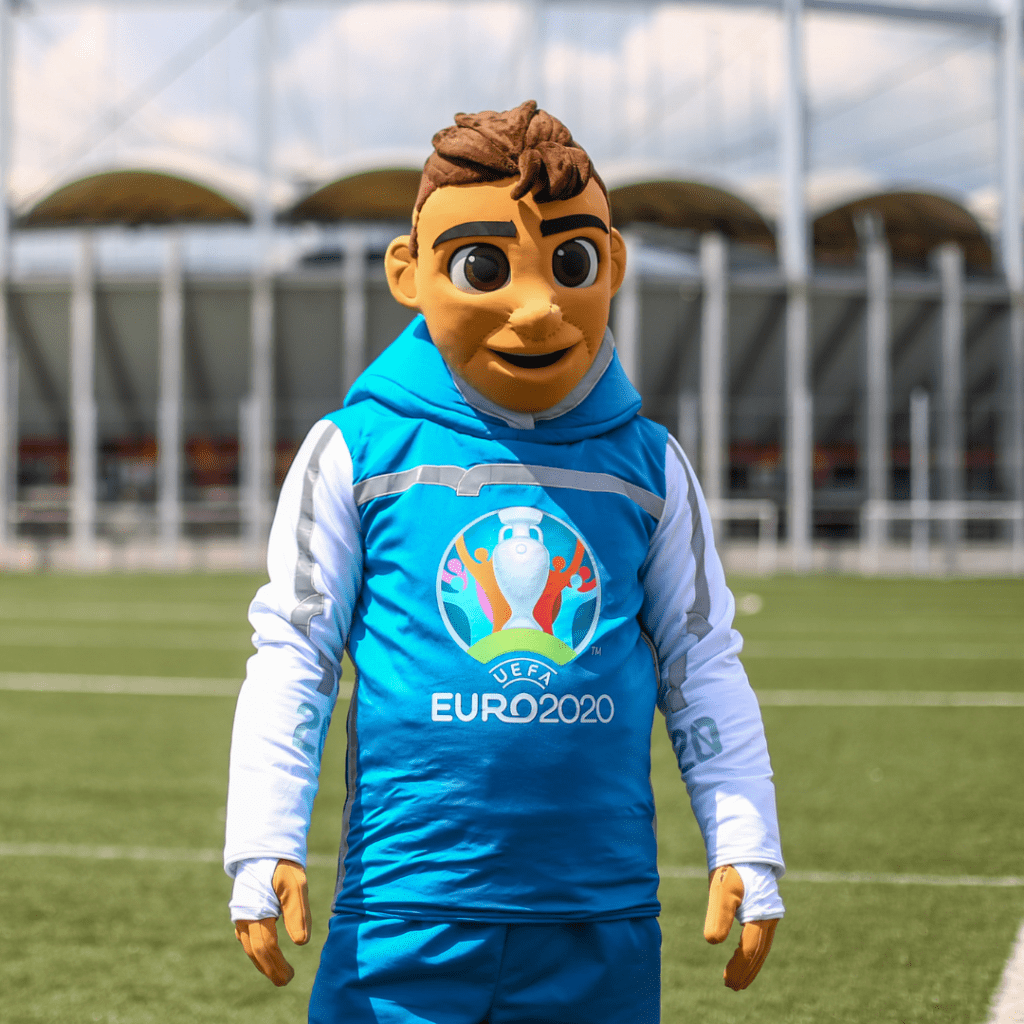
His goal is to bring together football fans from various nations and cultures and unite them for their common love of football. Another interesting thing about him is that it was also reported that the mascot was designed by the renowned Cruyff from the Netherlands.
France 2016: Super Victor
The official mascot of the 2016 European Football Championship, which was held in France, is Super Victor. The mascot is a child dressed in French football team gear. The name refers to the concept of winning and honing the superpower when the boy discovered the magic of gowns, swimwear, and balls.
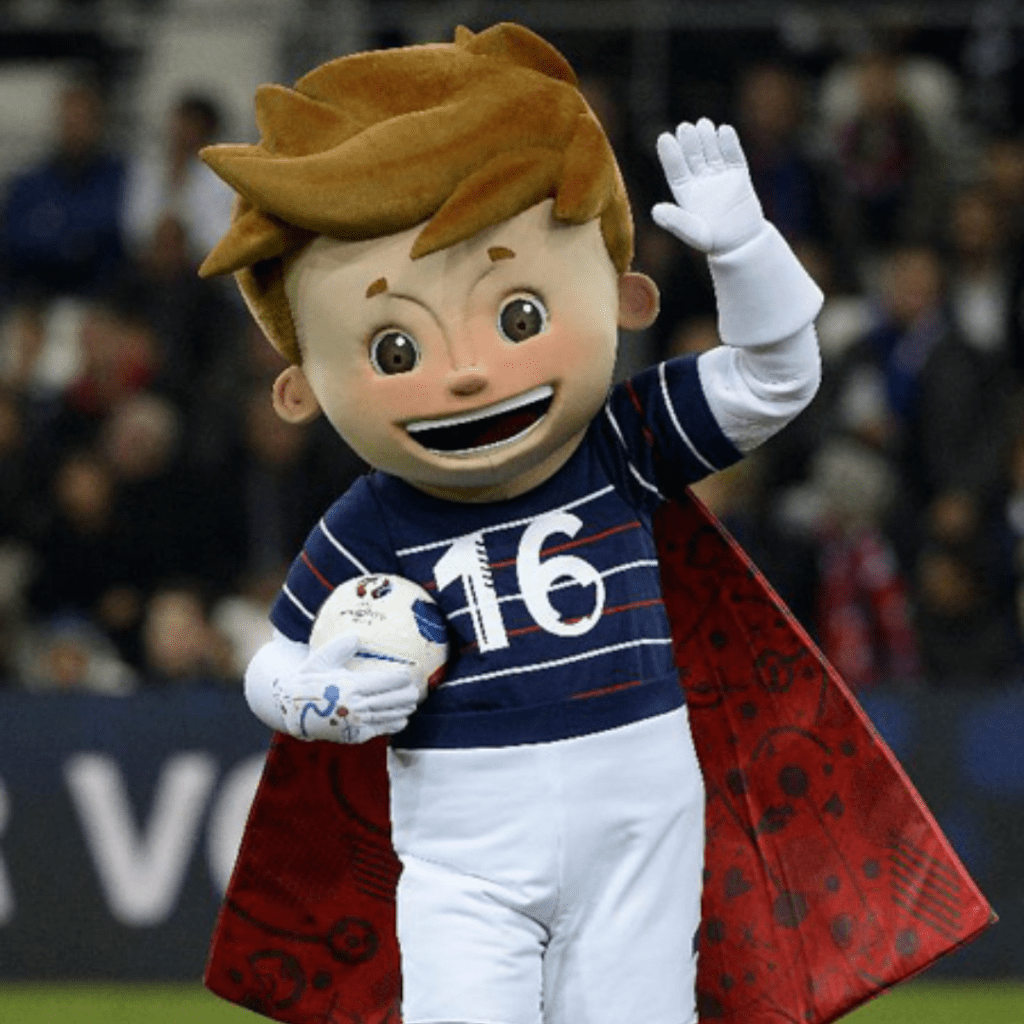
The mascot made its debut at the Vélodrome Stadium in Marseille, during a match between France and Sweden. The mascot’s name was finalized after receiving approximately 50,000 public votes on UEFA’s official website. Super Victor’s other competitive names were Driblou and Goalix.
Switzerland-Austria 2008: Flix And Trix
Flix and Trix were the official mascots for the 2008 European Championship, which was held in Switzerland and Austria. It was revealed by the UEFA press release that the mascots embody feelings of friendship, tolerance, teamwork, competition, style, and attitude.

Flix is said to have a cheekier personality, while Trix is more serious and has more self-control. The mascots were beautifully designed by the Warner Bros. Flix is seen wearing a red shirt and white pants while Trix is donning a white shirt and red pants with the numbers 20 and 8 imprinted on their jerseys.
Ukraine-Poland 2012: Slavek And Slavko
The UEFA EURO 2012 went for not just one mascot but two. Following the dual mascots in 2008, these two were dubbed the official mascots. The twins are known as Slavek and Slavko. Nearly 40,000 people weighted in on a poll to determine their names.

Slavek and Slavko were set to take on the mantle of the former twins Trix and Flix, who performed merry dance numbers throughout UEFA EURO 2008 held in Austria and Switzerland. The twins are seen wearing contrasting red and white and yellow and blue outfits with spiky hair.
Portugal 2004: Kinas
The UEFA EURO 2004 launched Kinas as their official mascot for the season. The mascot was unveiled before an audience of 45,000 spectators at a ceremony at the Casa Serralves auditorium in Porto. Kinas is seen wearing a brown shirt with green pants and the number 04 imprinted on the shirt.
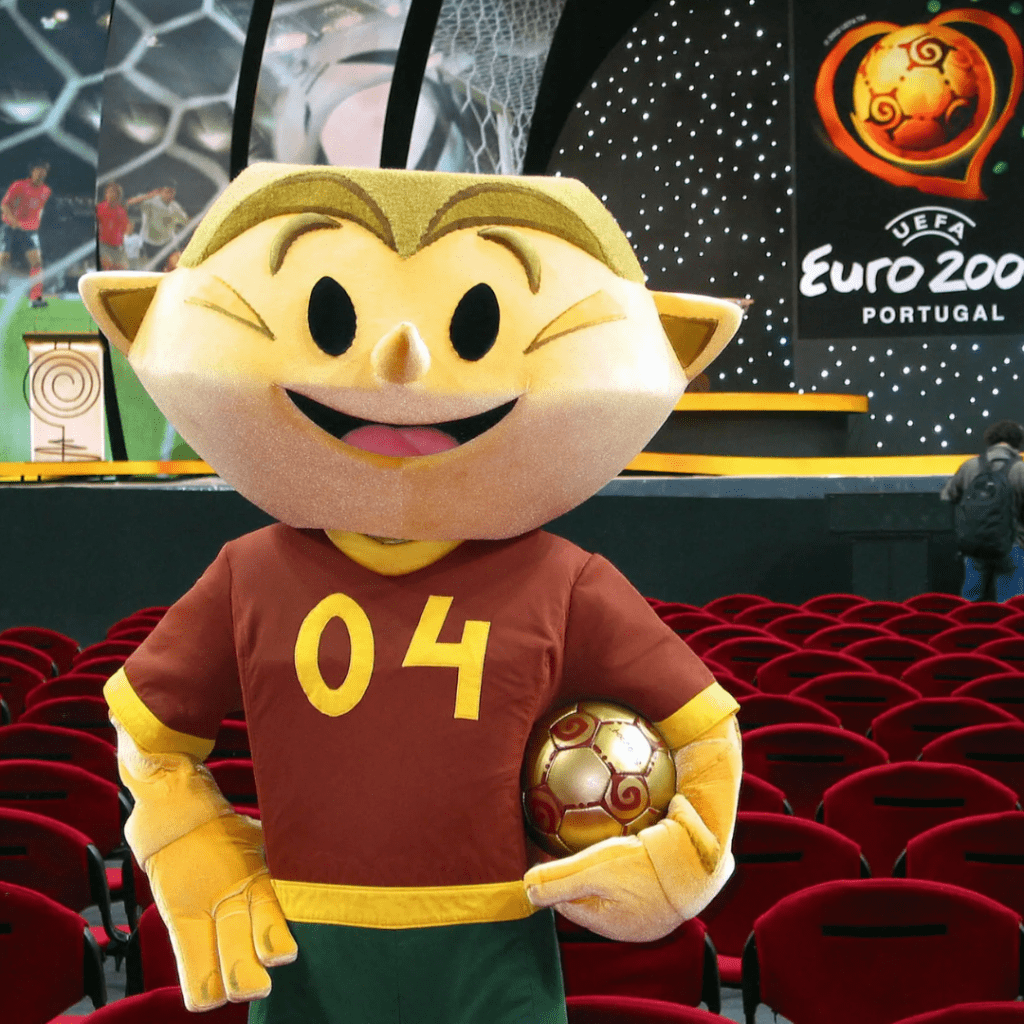
Kinas is a young Portuguese boy with special powers, and ever since his debut, he has been received quite well by the audience. The mascot is attractive in nature and dignifies the symbols of the country it is representing very efficiently.
Germany 2024: TBA
The 17th edition of the UEFA European Championship is all set to be held in 2024 with Germany as the host country. Furthermore, it is going to be the third time the tournament will be held on German football fields.
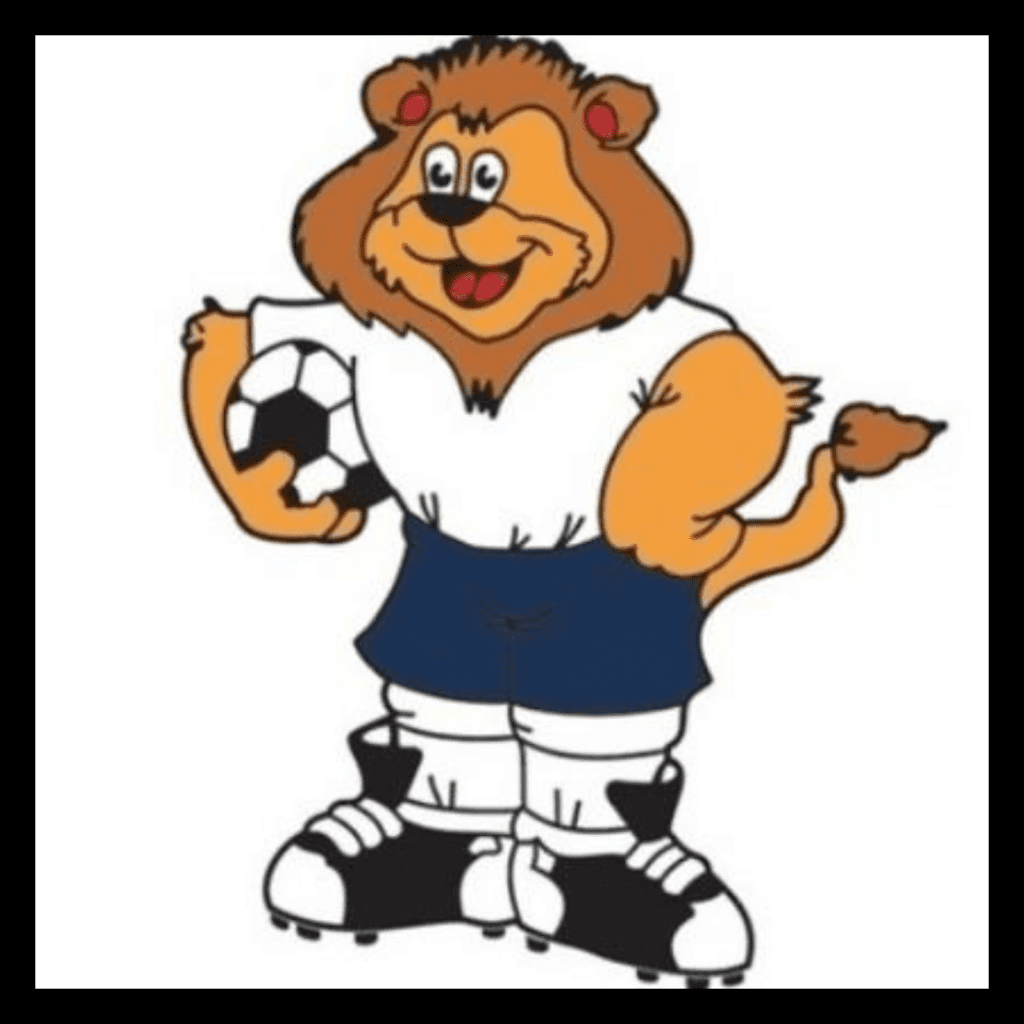
It seems like the mascot for the year 2024 will be a cheerful lion. The name of the lion is yet to be revealed. However, the lion is seen to embody a free-spirited mood donning a white jersey and blue pants with a football in its hand.
Cameroon 2021: Mola
“Mola” was the official mascot of the AFCON 2021. It is a lion wearing the Indomitable Lions of Cameroon’s national green, red, and yellow jersey. In Cameroon, the name Mola can refer to a friend, an elder, or an uncle, among many other things.
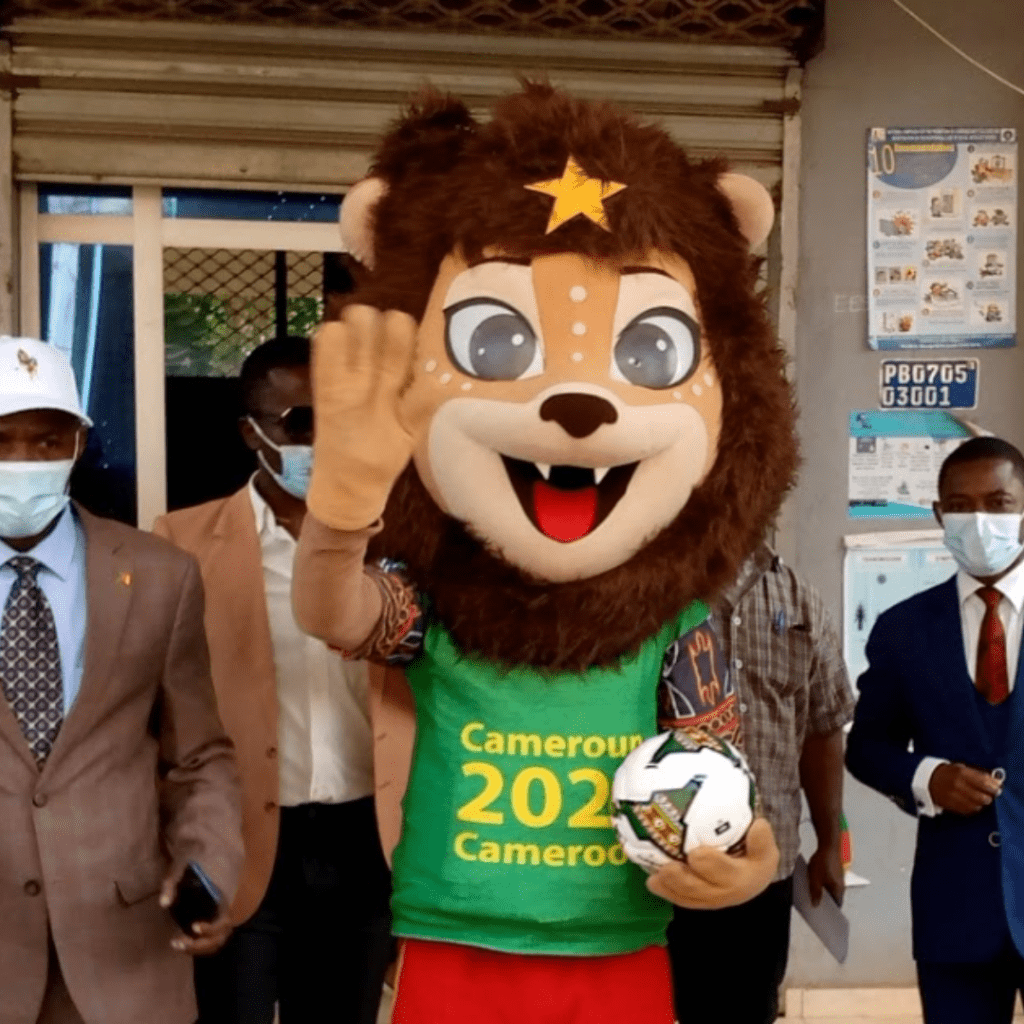
Mola embodies the convivial and friendly nature of Cameroonians. The lion is also seen sporting a green jersey with the words “Cameroon 2021” printed on it. It seems that lions are popular among sports mascots, perhaps due to their inherently powerful persona.
Gabon 2017: Samba
The 2017 Africa Cup of Nations was hosted by Gabon, and its mascot is a fierce black panther known as Samba. Samba means “hello” and “welcome” in the local Bantu language. As for the clothing, the mascot is seen sporting blue and yellow colors.
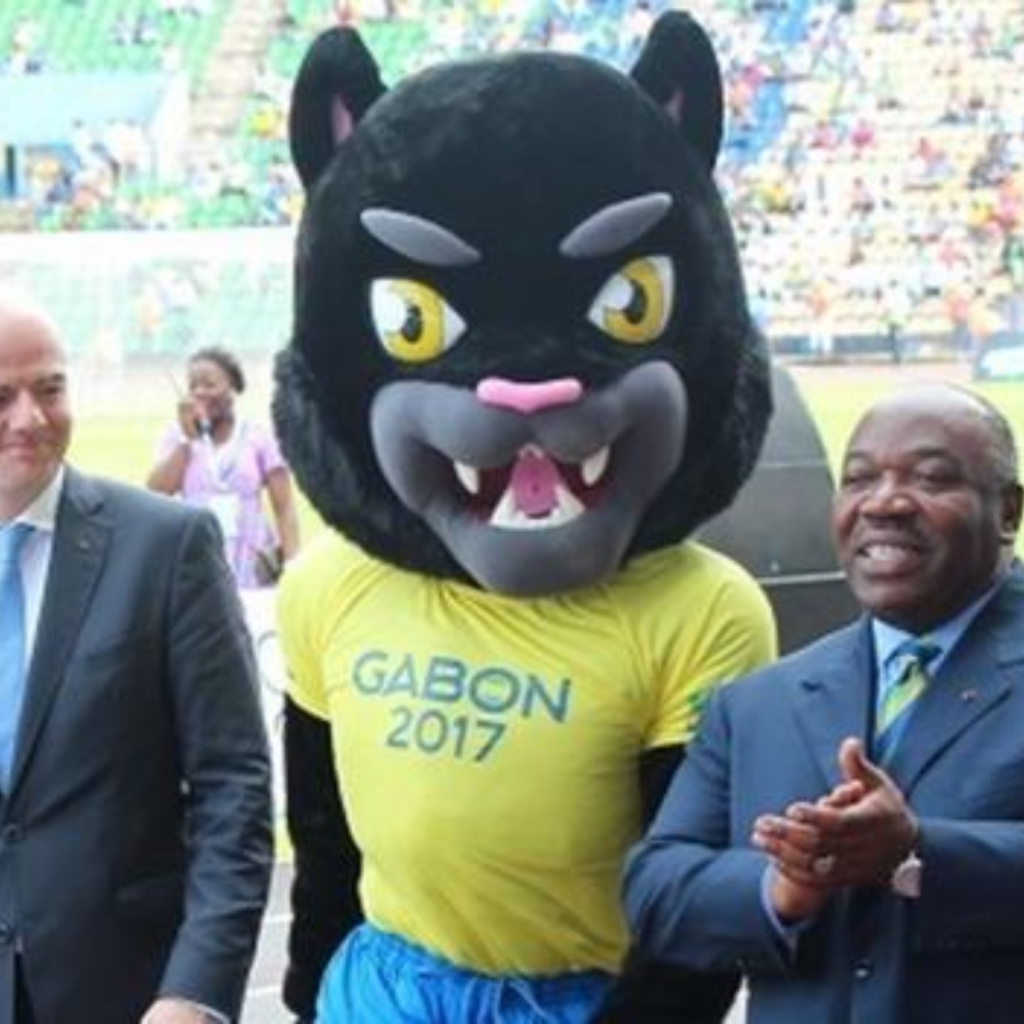
Samba is seen as a symbol of strength and power. He also embodies a sense of celebration and fun, similar to the legendary Gabonese hospitality. With its claws out, thumbs up, and wide grin, Samba has proudly represented the Gabonese culture.
Mexican National Team: Kin
Kin is the official mascot that represents the Mexican National football team. Mexico has qualified for seventeen World Cups so far. The team is also historically the most successful national team in the CONCACAF region. With that record, it makes sense that they’d go for a unique mascot.
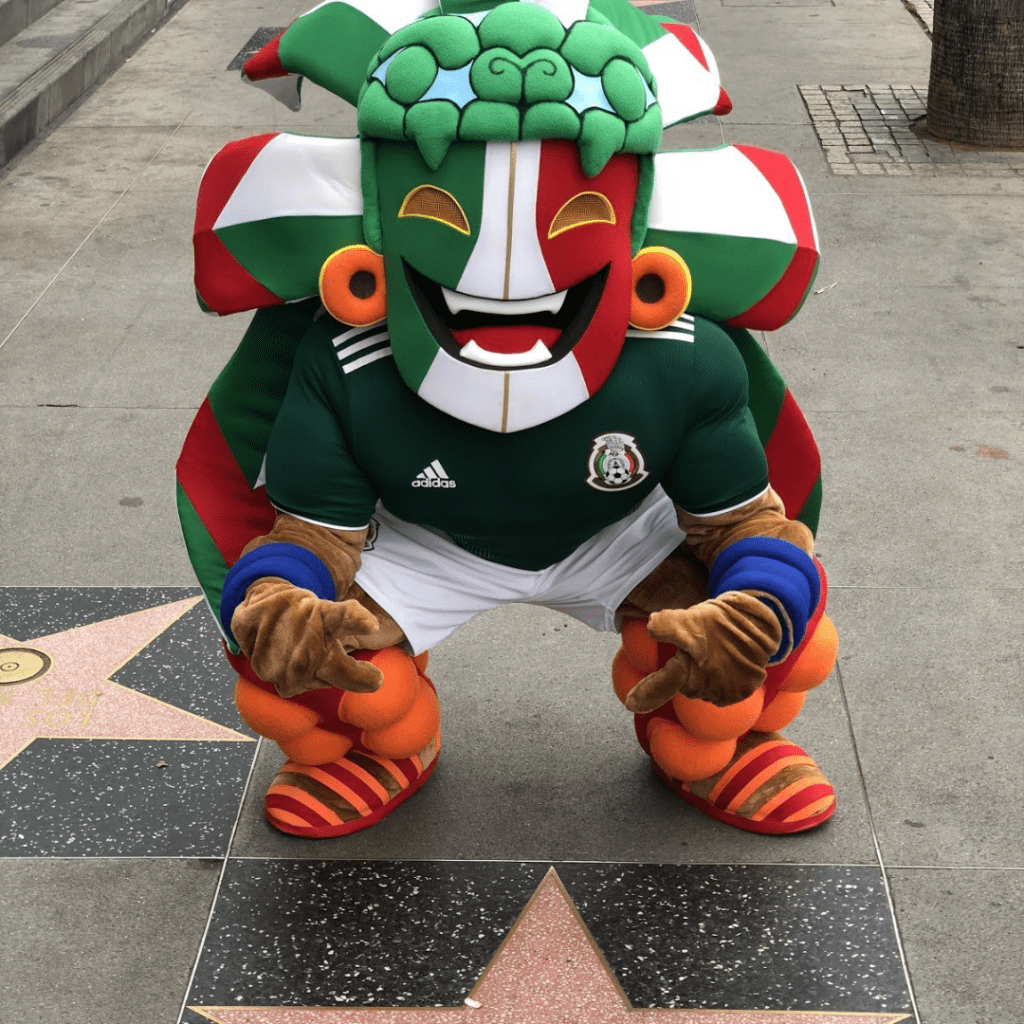
Mexico’s official mascot is seen sporting an exotic look. Kin is always seen giving smiles and hugs to the audience, showing the same energy that human football fans have. It has a particularly muscular physique. It wears a green t-shirt with the number 12 written on it.
Belgium: Red the devil
Since the beginning of the Belgium national team there has always been a mascot with them, the first one they had was a lion called Diabolix but he did his las apperence in 1980 where then fans repleaced him with homemade costumes in order to keep support their country.
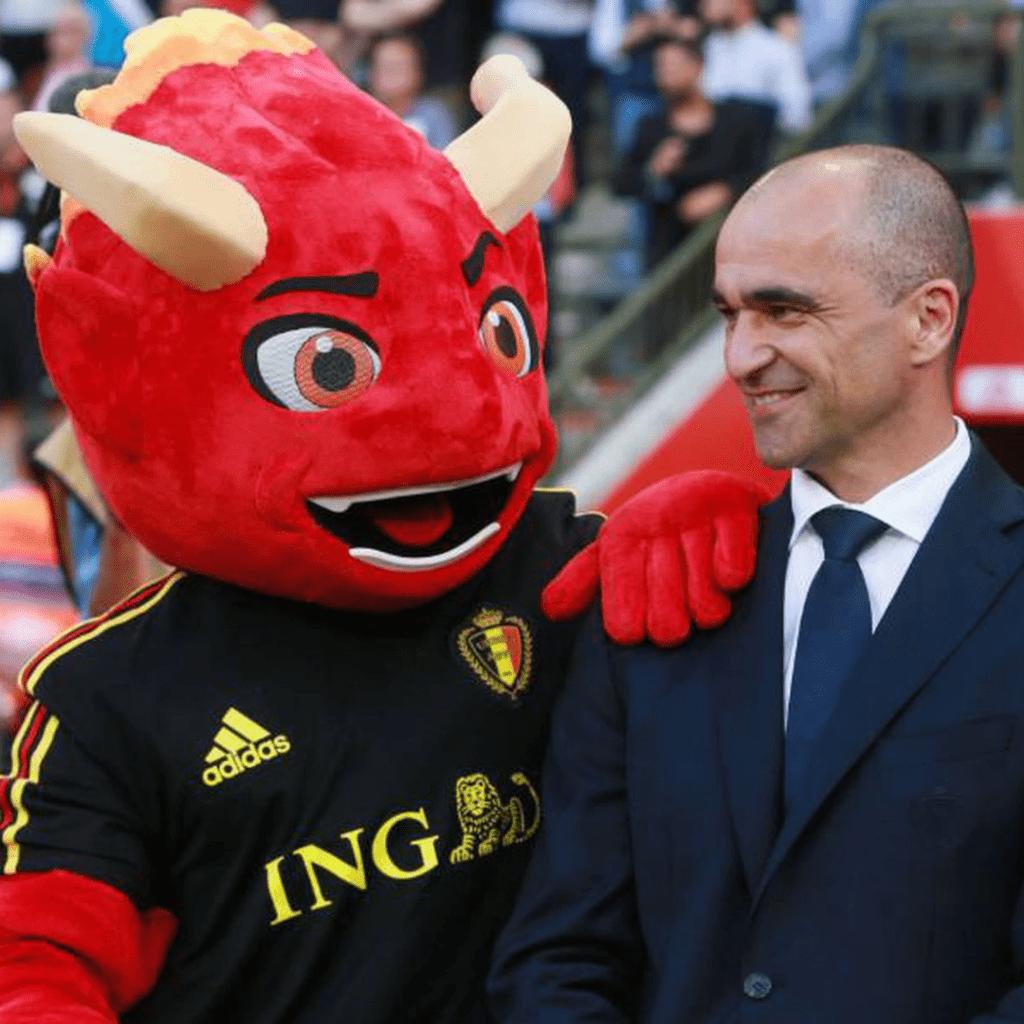
Red was introduced to the Belgian people in a friendly match in 2018 after there was a big votation in the newspapers where the majority of the population participated. With over 46% of the total votes, Red became the new mascot.
Brazil 2018: Canarinho
The FIFA World Cup 2018 mascot of Brazil was an angry bird named Canarinho. The yellow Canary bird has a particular facial expression that we haven’t seen in other mascots. This mascot seems to be in a furious mood all the time.
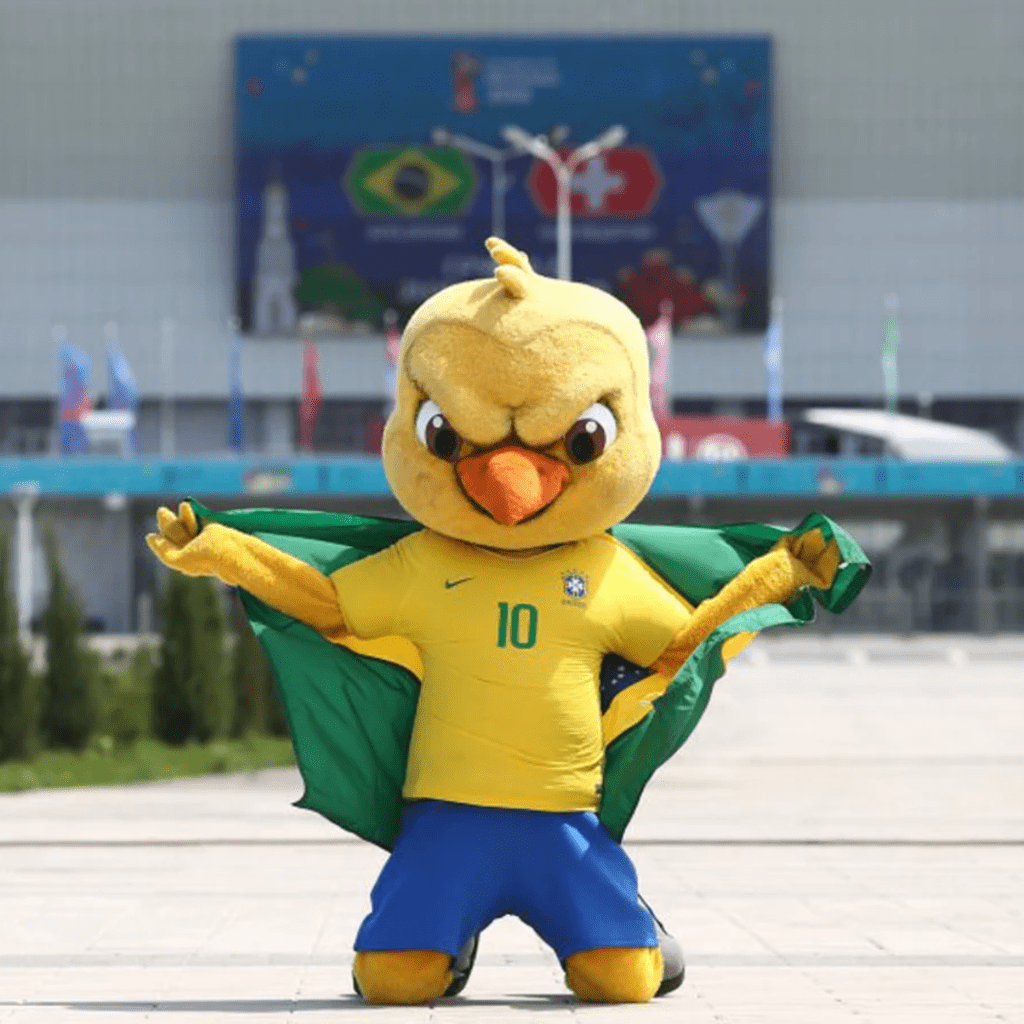
This mascot surely emulates the look of a beefy Tweety bird, and we’re still wondering who did it so dirty for it to be that furious in the first place. Aside from the angry glare, the bird is seen dressed in Brazil’s traditional yellow and blue uniform.
Japan 2014: Pikachu
Although the 2014 FIFA mascot was Fuleco, the Japanese team brought along their own mascot — Pikachu. Pikachu is arguably the most well-known character in the Pokemon series, and we’re glad that the blue samurai team was represented by a worthy mascot.
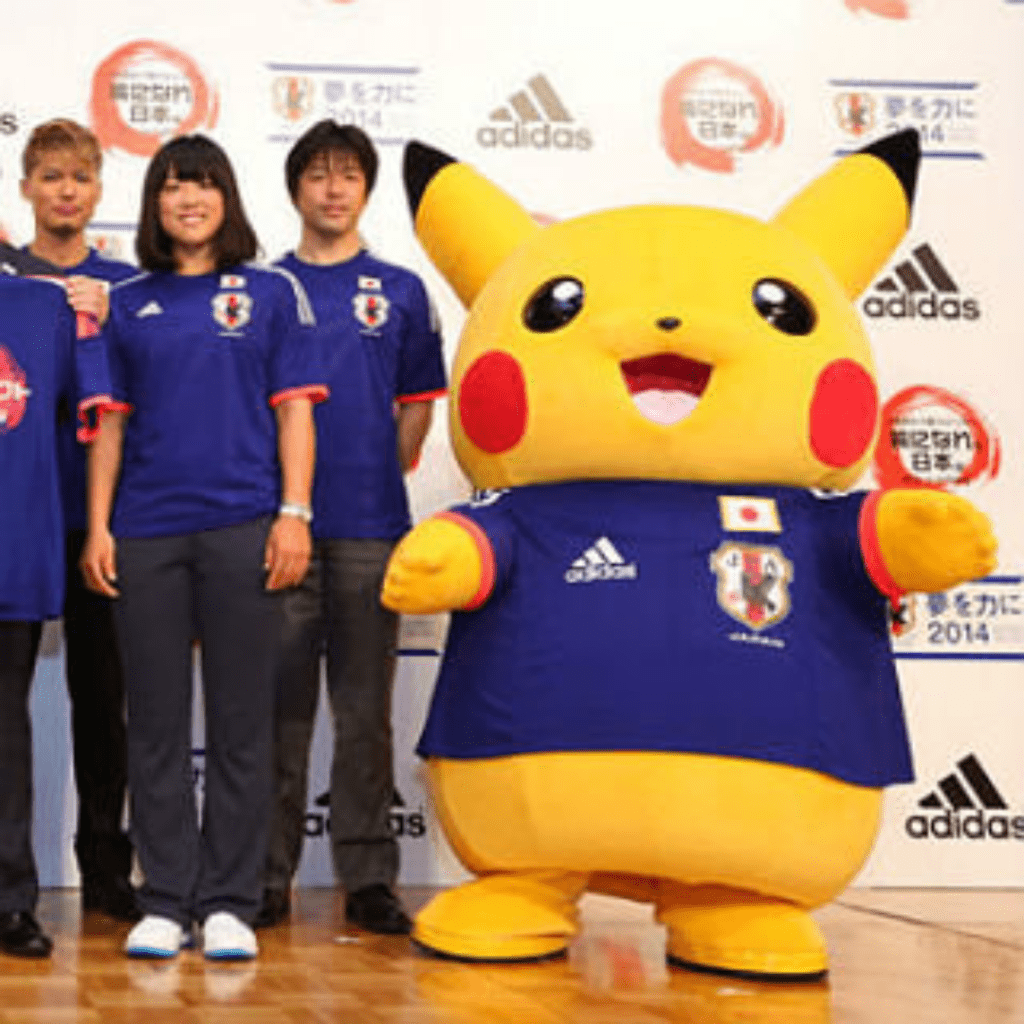
This vision was brought to life by a thoughtful partnership between Adidas and Nintendo. The partnership encourages players in uniform to act as a single “engine” and manifest unity. Seeing Pikachu as a mascot definitely warms our hearts with nostalgia.
Uruguay 2022: Pato Celeste
The 2022 FIFA World Cup will take place in Qatar, and it is just around the corner. It is a history-making event as an Arab nation is going to be hosting it for the first time. The Uruguayan football supporters revealed an official mascot called El Pato Celeste, or the Blue Duck, for the World Cup qualifying match.
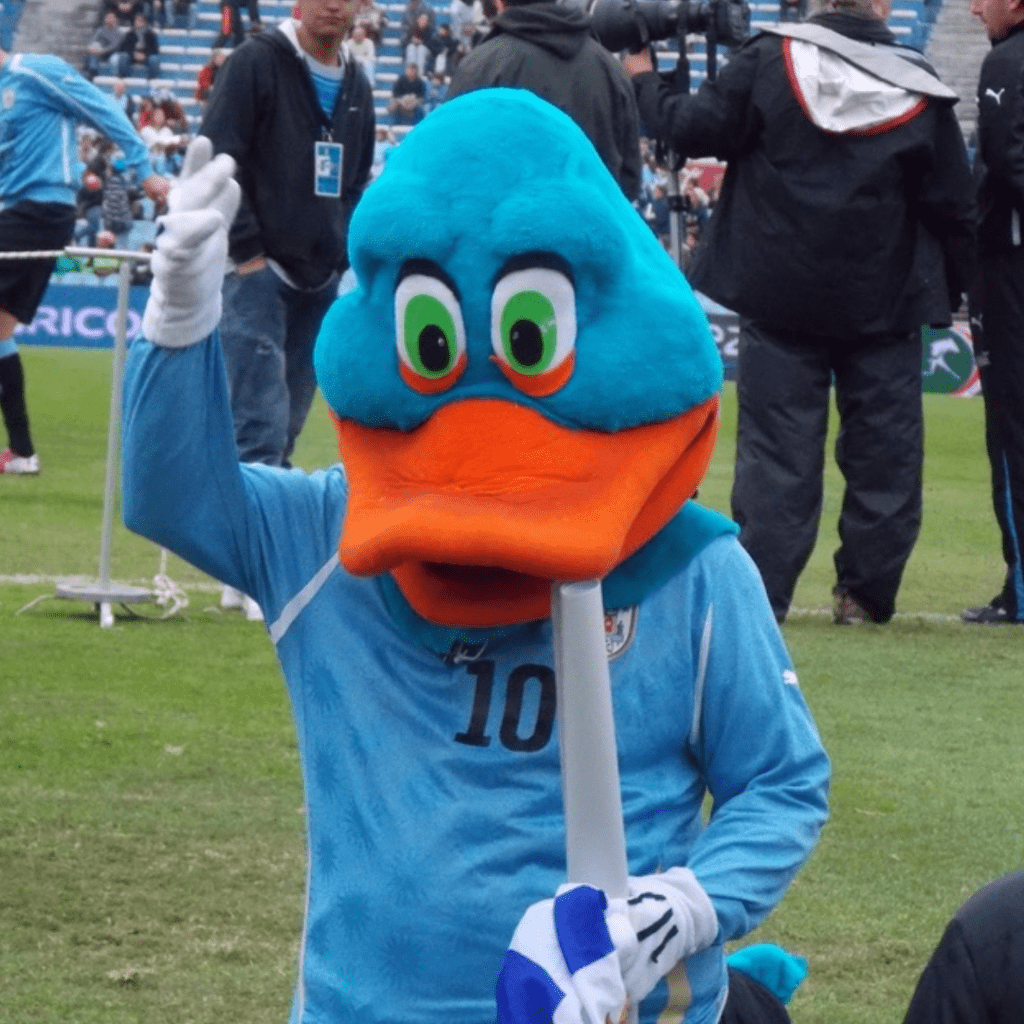
Although it was never officially recognized, Pato has long served as the mascot of Uruguay’s national team. For many years, the mascot has accompanied the team to all of their games, until it was recently prohibited from entering the field. But we’re sure he’ll be in the stands cheering on the team.
Spain 2022: Musa
Musa, a water-loving dog, was recently named the official mascot of the Spanish football team. The dog is known throughout Spain for its easygoing, cheerful, loyal, and intelligent personality. Mascots are traditionally humans in costumes or drawings…

…but for the World Cup 2022, Spain has taken a unique route and chose an animal mascot to represent their team going into the Qatar World Cup. Spain has already confirmed their place in Qatar and will rely on the motivation of Musa, the Spanish water dog.
Chile: Rogelio
The Chilean football team’s official mascot is Rogelio the dog. The dog has fluffy white skin and wears a red jersey and blue pants. All these colors, along with the star over its eye, represent the national flag of Chile.
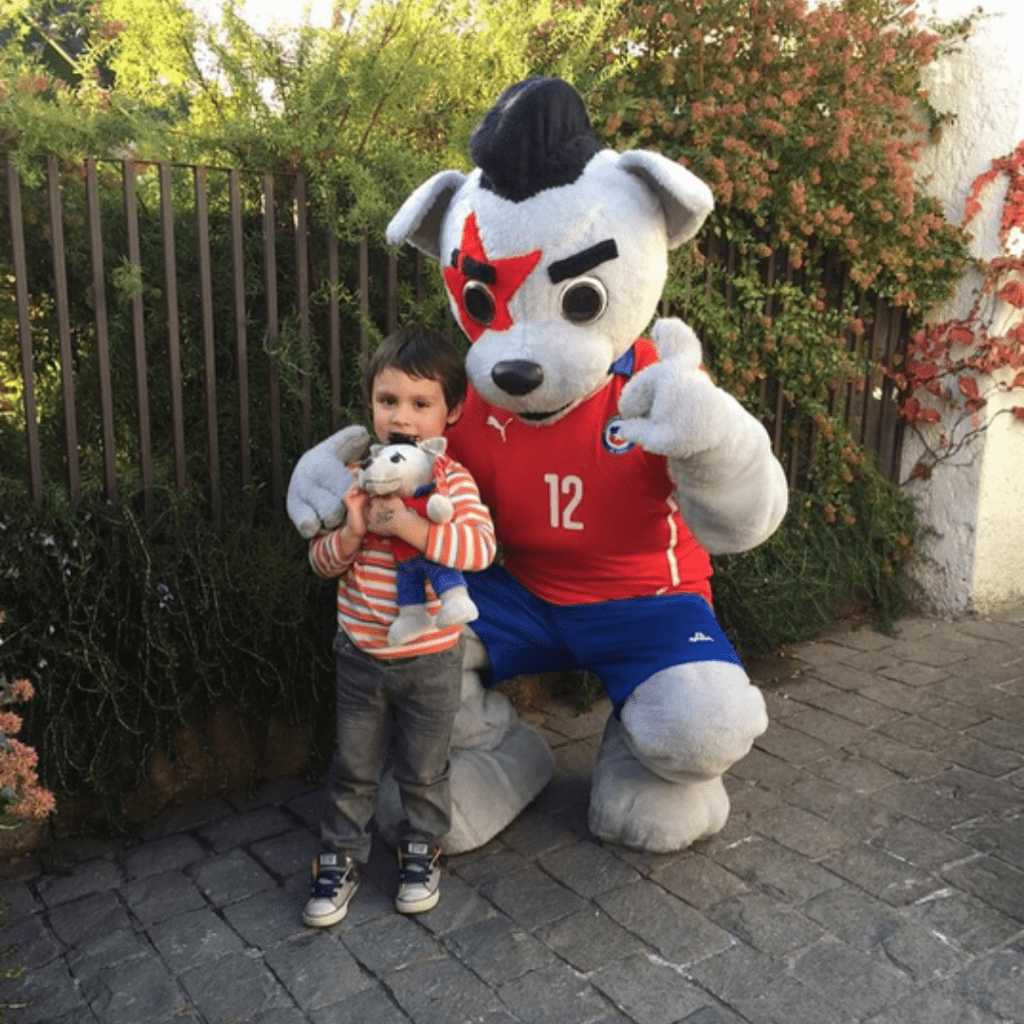
Since 2014, Rogelio the dog has accompanied the Chilean national team in all of their games. The mascot has captivated all of his fans so much so that all of the items in which he appears sells out quite rapidly.
Netherlands: Orange Lion
There are two things that are nearly impossible to ignore when you attend a Netherlands-based game. The first is that most Holland supporters favor wearing orange. The second is the immense love of lions in the Netherlands — a common theme we’ve seen with other teams.
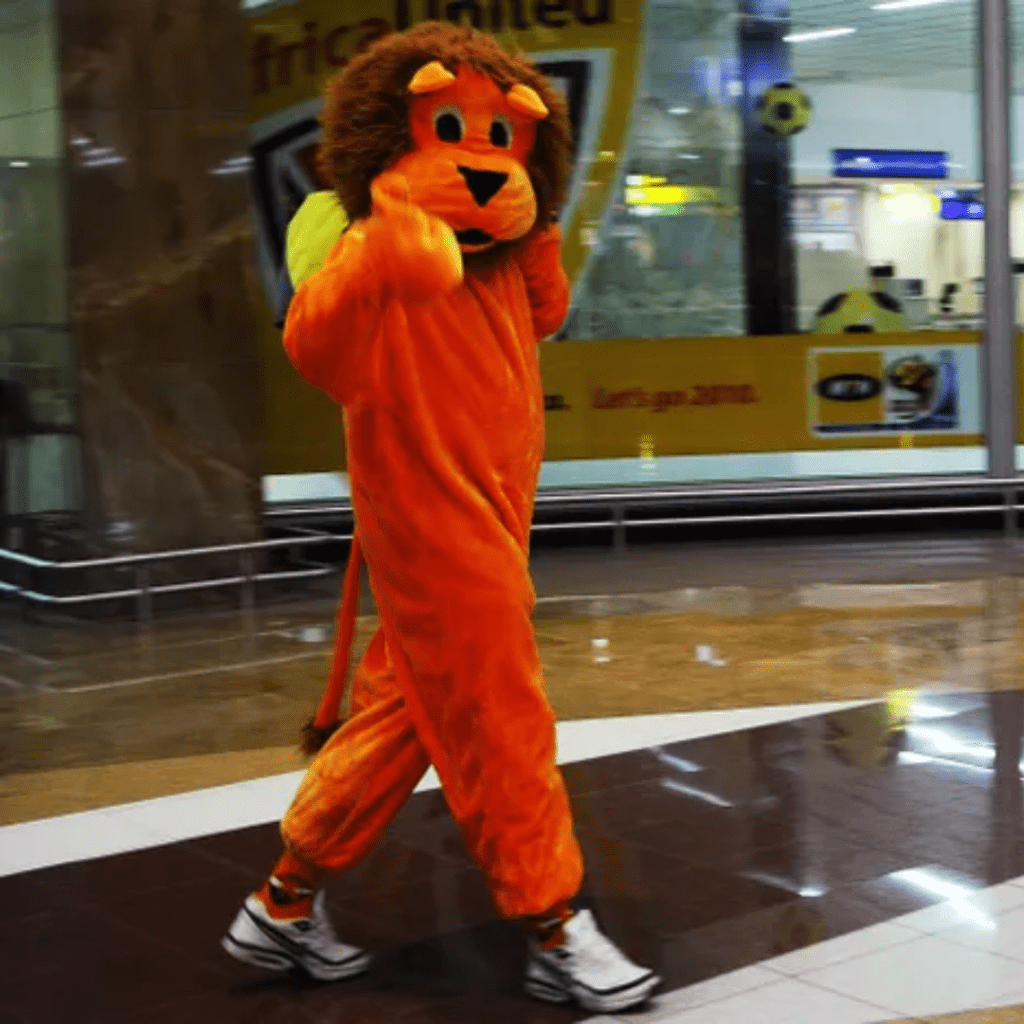
Hundreds of supporters regularly dress up as orange lions in any match that has a relation to the Dutch. Additionally, the color orange is the color of the royal house and various national sports teams in the Netherlands. Meanwhile, the lion is their traditional emblem that has withstood the test of time.
